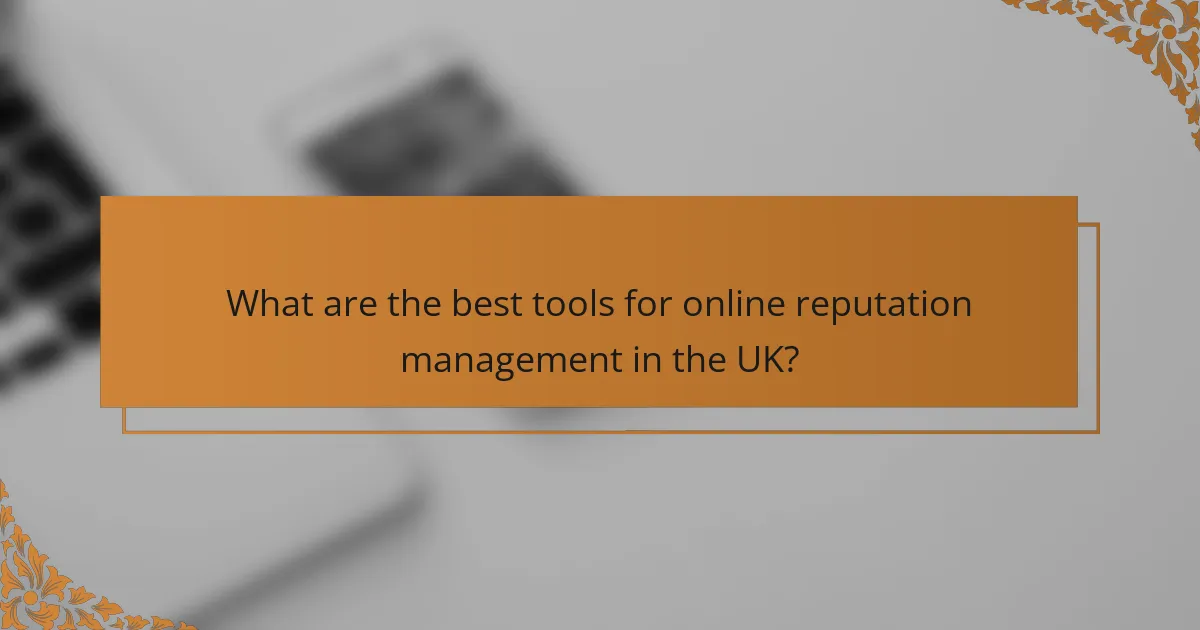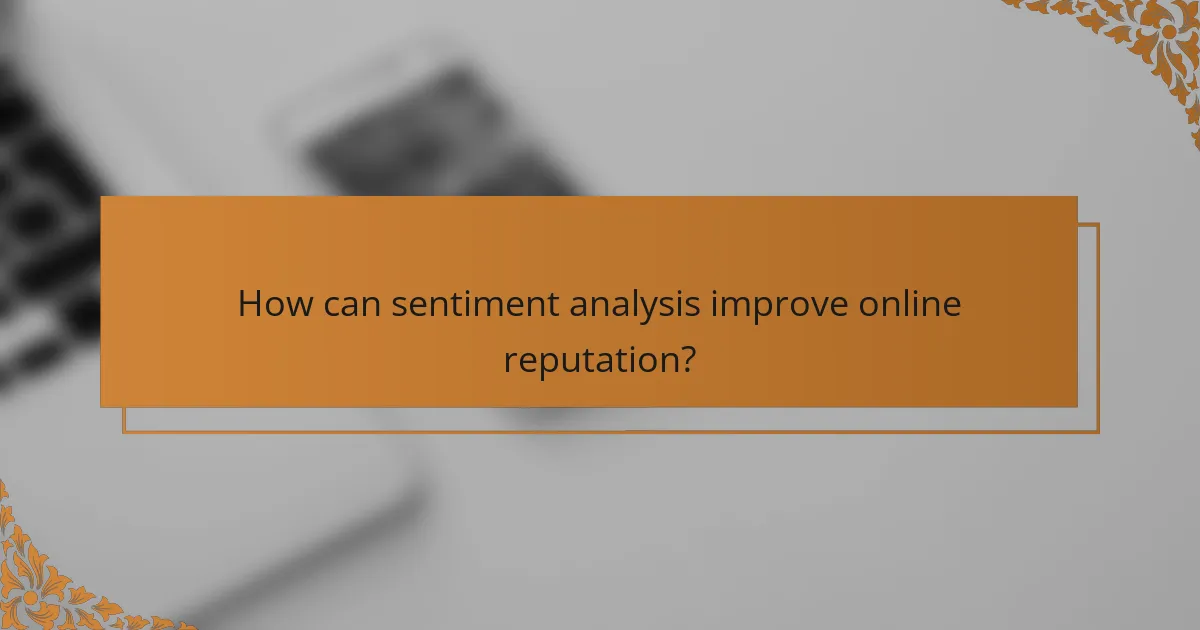Online reputation management is essential for businesses aiming to maintain a positive presence in the digital landscape. By leveraging sentiment analysis and various tools, companies can gain valuable insights into customer opinions and emotions, enabling them to respond effectively and enhance their brand image. Proactive strategies such as social media monitoring and review management play a crucial role in fostering customer satisfaction and loyalty.

What are the best tools for online reputation management in the UK?
The best tools for online reputation management in the UK help businesses monitor and improve their online presence. These tools provide insights into customer sentiment, track reviews, and manage brand mentions across various platforms.
Brand24
Brand24 is a powerful social media monitoring tool that allows businesses to track their online reputation in real-time. It collects mentions of your brand across social media, blogs, and news sites, providing insights into public sentiment.
With features like sentiment analysis and influencer tracking, Brand24 helps identify key discussions about your brand. It offers a user-friendly dashboard to visualize data and respond promptly to customer feedback.
Reputology
Reputology specializes in managing online reviews, making it ideal for businesses that rely heavily on customer feedback. It aggregates reviews from various platforms, allowing users to monitor their reputation in one place.
This tool enables businesses to respond to reviews directly and analyze customer sentiment over time. Its reporting features help identify trends and areas for improvement, ensuring a proactive approach to reputation management.
Hootsuite
Hootsuite is primarily known as a social media management tool, but it also offers reputation management features. Users can schedule posts, monitor brand mentions, and engage with customers across multiple platforms.
By using Hootsuite’s analytics, businesses can assess the effectiveness of their social media strategies and adjust their approach based on audience sentiment. It’s a comprehensive tool for maintaining a positive online presence.
Google Alerts
Google Alerts is a free tool that notifies users about new mentions of their brand across the web. By setting up alerts for specific keywords, businesses can stay informed about what is being said about them online.
This tool is straightforward to use and can be a valuable part of a reputation management strategy. However, it may not capture all mentions, so it’s best used in conjunction with other tools for comprehensive monitoring.
Trustpilot
Trustpilot is a review platform that allows customers to leave feedback about their experiences with a business. It plays a crucial role in online reputation management by providing a space for genuine customer reviews.
Businesses can respond to reviews, which helps build trust and improve customer relationships. Maintaining a strong presence on Trustpilot can enhance a brand’s reputation and influence potential customers’ decisions.

How can sentiment analysis improve online reputation?
Sentiment analysis enhances online reputation by evaluating customer emotions and opinions expressed in digital content. By understanding these sentiments, businesses can respond effectively to feedback, improve customer satisfaction, and build a positive brand image.
Identifying customer emotions
Sentiment analysis helps businesses identify the emotions behind customer feedback, whether it’s positive, negative, or neutral. By analyzing social media posts, reviews, and comments, companies can gauge public sentiment and detect emerging trends in customer feelings.
For instance, a sudden spike in negative sentiment regarding a product can alert a company to potential issues, allowing for timely intervention. Tools like natural language processing can automate this analysis, making it easier to track customer emotions over time.
Enhancing brand perception
Understanding customer sentiment allows businesses to enhance their brand perception by addressing concerns and highlighting positive feedback. By actively engaging with customers who express dissatisfaction, companies can turn negative experiences into positive ones, fostering loyalty.
For example, responding to negative reviews with empathy and solutions can improve public perception and encourage other customers to view the brand more favorably. Regularly monitoring sentiment also helps brands adjust their messaging to align with customer expectations.
Guiding marketing strategies
Sentiment analysis provides valuable insights that can guide marketing strategies and campaigns. By understanding what resonates with customers, businesses can tailor their messaging and promotional efforts to better meet audience needs.
For example, if sentiment analysis reveals that customers appreciate sustainability, a brand might emphasize eco-friendly practices in its marketing. Additionally, tracking sentiment over time can help assess the effectiveness of marketing campaigns and inform future initiatives.

What techniques are effective for managing online reputation?
Effective online reputation management involves proactive strategies that monitor and enhance your brand’s image. Key techniques include social media monitoring, responding to reviews, and creating SEO-optimized content.
Monitoring social media
Monitoring social media is crucial for managing online reputation as it allows you to track mentions of your brand in real-time. Tools like Hootsuite or Brandwatch can help you identify trends, gauge public sentiment, and respond quickly to any negative feedback.
Establish a routine for checking social media platforms regularly, ideally daily or weekly, to stay informed about what is being said about your brand. Set up alerts for specific keywords related to your business to ensure you never miss a mention.
Responding to reviews
Responding to reviews, both positive and negative, is essential for building trust and credibility. Acknowledge positive feedback with gratitude and address negative comments with empathy and solutions to demonstrate your commitment to customer satisfaction.
Develop a response strategy that includes guidelines on tone and timing. Aim to respond to reviews within 24-48 hours, as timely responses can significantly impact customer perceptions and encourage more positive interactions.
Content creation and SEO
Creating high-quality content and optimizing it for search engines can significantly influence your online reputation. Focus on producing informative blog posts, articles, and videos that highlight your expertise and address common customer concerns.
Incorporate relevant keywords naturally into your content to improve its visibility in search results. Regularly update your website and blog to keep content fresh and engaging, which can help push down negative search results over time.

What are the key metrics for measuring online reputation?
The key metrics for measuring online reputation include Net Promoter Score (NPS), sentiment score, and brand mentions. These metrics provide insights into customer perceptions, emotional responses, and overall visibility of a brand online.
Net Promoter Score (NPS)
Net Promoter Score (NPS) gauges customer loyalty by asking how likely customers are to recommend a brand to others on a scale from 0 to 10. Responses categorize customers into promoters, passives, and detractors, allowing businesses to calculate their NPS by subtracting the percentage of detractors from promoters.
A strong NPS typically ranges from the low twenties to the high fifties, indicating a healthy level of customer satisfaction and loyalty. Regularly measuring NPS can help identify trends and areas for improvement in customer experience.
Sentiment score
Sentiment score measures the emotional tone of online mentions about a brand, often derived from social media, reviews, and other user-generated content. This score can range from negative to positive, providing a quick snapshot of public perception.
Tools that analyze sentiment often use natural language processing to classify comments as positive, negative, or neutral. Monitoring sentiment scores over time helps brands understand shifts in public opinion and respond proactively to negative feedback.
Brand mentions
Brand mentions track how often a brand is discussed across various online platforms, including social media, blogs, and news articles. This metric helps assess brand visibility and engagement with the audience.
Regularly analyzing brand mentions can reveal trends in consumer interest and highlight potential issues before they escalate. Tools that aggregate mentions can provide insights into the context and sentiment surrounding each mention, aiding in reputation management strategies.

What prerequisites should businesses consider for effective reputation management?
For effective reputation management, businesses should establish a clear understanding of their brand identity and the perceptions of their stakeholders. This involves setting measurable goals, understanding the competitive landscape, and being aware of the legal and ethical considerations in their industry.
Understanding target audience
Understanding the target audience is crucial for effective reputation management. Businesses must identify who their customers are, what they value, and how they communicate. This insight helps tailor messaging and engagement strategies that resonate with the audience.
To gain a deeper understanding of the target audience, companies can utilize surveys, social media analytics, and customer feedback. These tools provide valuable data on customer preferences, behaviors, and sentiments, allowing businesses to refine their approach.
Additionally, segmenting the audience based on demographics, interests, and behaviors can enhance targeting efforts. For instance, a business might find that younger consumers prefer digital communication channels, while older demographics respond better to traditional methods. This knowledge enables more effective reputation management strategies that align with audience expectations.
